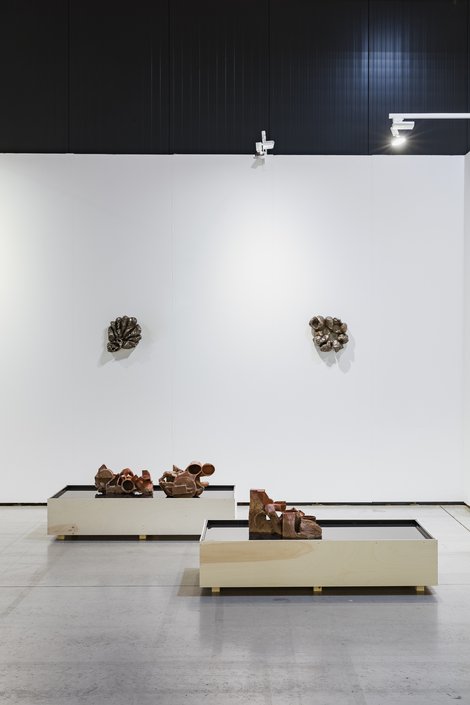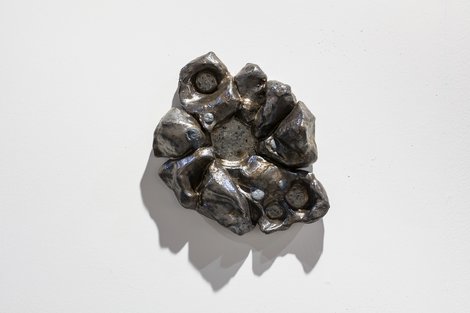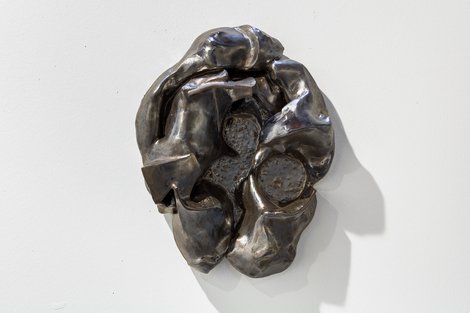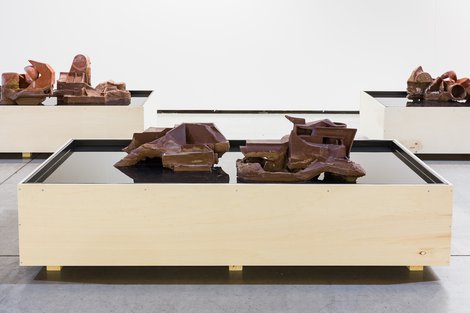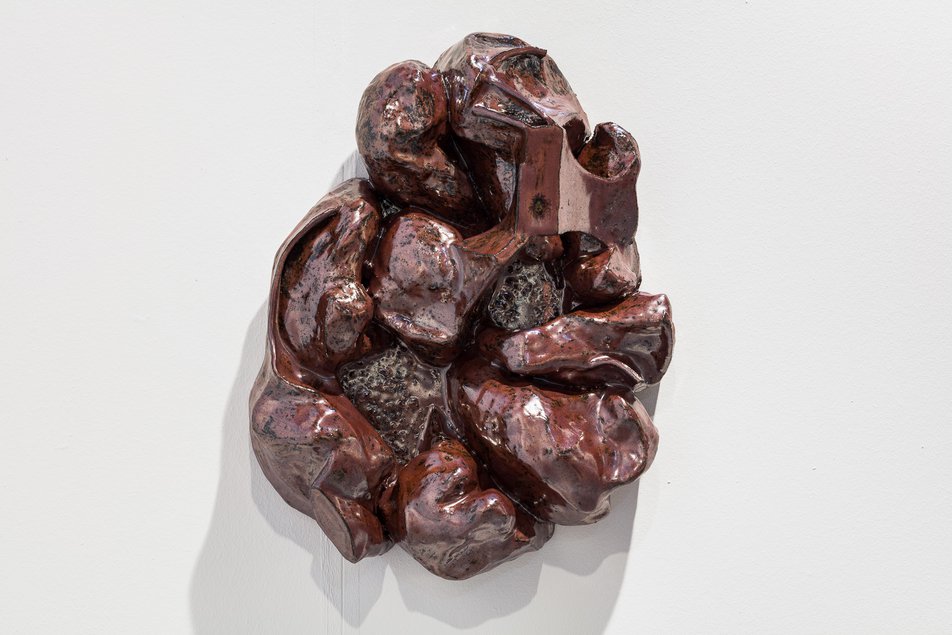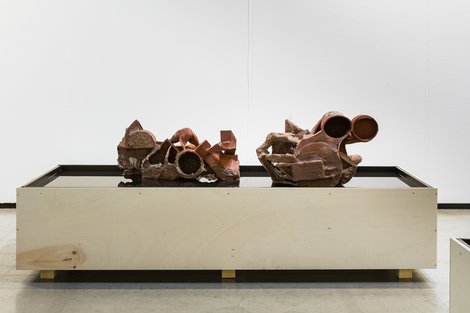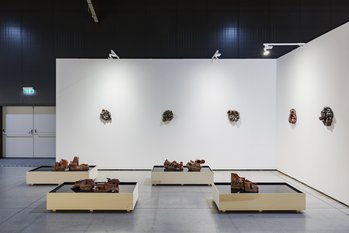viennacontemporary 2020
Laurence Sturla
Laurence Sturla
GIANNI MANHATTAN is pleased to present two new bodies of work by Laurence Sturla (b.1992, Swindon, UK; lives and works in Vienna).
The first series is called ‘But all they found were tide lines’, consisting of troughs on the floor, in which ceramics are placed. The almost coffin sized pedestals are an integral part of the work and contain salt water which enables a reaction in Sturla’s high fired ceramic works, rendering the works as time based pieces. Through his experiments in the studio he understood that high fired ceramics, despite their vitrification, are still porous enough to allow a form of osmosis to happen as the ceramic sit in water. Over the duration of the fair, the works are developing and changing and absorbing some of the salty water solution, and as a result they sweat out salt crystals. The base of the objects is coated with a clay and mineral solution, which, over the course of the fair, will crumble and disintegrate.
The visual language of his ceramic sculptures is teetering and seems to be part industrial, mechanical, part car engine, part architecture. They illustrate the fallacy between technological precision and our (in)ability to recall and visually digest space, function or logic.
The first series is called ‘But all they found were tide lines’, consisting of troughs on the floor, in which ceramics are placed. The almost coffin sized pedestals are an integral part of the work and contain salt water which enables a reaction in Sturla’s high fired ceramic works, rendering the works as time based pieces. Through his experiments in the studio he understood that high fired ceramics, despite their vitrification, are still porous enough to allow a form of osmosis to happen as the ceramic sit in water. Over the duration of the fair, the works are developing and changing and absorbing some of the salty water solution, and as a result they sweat out salt crystals. The base of the objects is coated with a clay and mineral solution, which, over the course of the fair, will crumble and disintegrate.
The visual language of his ceramic sculptures is teetering and seems to be part industrial, mechanical, part car engine, part architecture. They illustrate the fallacy between technological precision and our (in)ability to recall and visually digest space, function or logic.
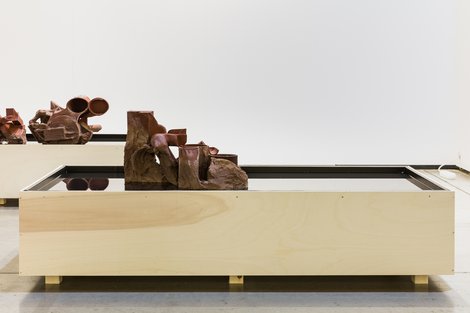
24.09.20—27.09.20
Marx Halle, Karl-Farkas-Gasse 19, 1030 Vienna
> Installation views
GIANNI MANHATTAN is pleased to present two new bodies of work by Laurence Sturla (b.1992, Swindon, UK; lives and works in Vienna).
The first series is called ‘But all they found were tide lines’, consisting of troughs on the floor, in which ceramics are placed. The almost coffin sized pedestals are an integral part of the work and contain salt water which enables a reaction in Sturla’s high fired ceramic works, rendering the works as time based pieces. Through his experiments in the studio he understood that high fired ceramics, despite their vitrification, are still porous enough to allow a form of osmosis to happen as the ceramic sit in water. Over the duration of the fair, the works are developing and changing and absorbing some of the salty water solution, and as a result they sweat out salt crystals. The base of the objects is coated with a clay and mineral solution, which, over the course of the fair, will crumble and disintegrate.
The visual language of his ceramic sculptures is teetering and seems to be part industrial, mechanical, part car engine, part architecture. They illustrate the fallacy between technological precision and our (in)ability to recall and visually digest space, function or logic.
The first series is called ‘But all they found were tide lines’, consisting of troughs on the floor, in which ceramics are placed. The almost coffin sized pedestals are an integral part of the work and contain salt water which enables a reaction in Sturla’s high fired ceramic works, rendering the works as time based pieces. Through his experiments in the studio he understood that high fired ceramics, despite their vitrification, are still porous enough to allow a form of osmosis to happen as the ceramic sit in water. Over the duration of the fair, the works are developing and changing and absorbing some of the salty water solution, and as a result they sweat out salt crystals. The base of the objects is coated with a clay and mineral solution, which, over the course of the fair, will crumble and disintegrate.
The visual language of his ceramic sculptures is teetering and seems to be part industrial, mechanical, part car engine, part architecture. They illustrate the fallacy between technological precision and our (in)ability to recall and visually digest space, function or logic.
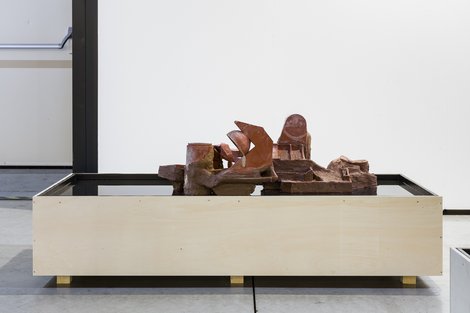
Sturla, fascinated by history and archaeology, thinks about how we understand previous societies and civilisations by reconstructing fragments, utilises leftovers from archaeological dig sites. His practice is driven by questions how an image of a society can be built from discarded and broken bits of debris.
Which already leads to the second series that’s on the wall called ‘Living wage’. They are imagined birds eye view renderings of archaeological digs. Each fired with earthy ceramic glazes (iron oxide glaze and bronze glaze) which is why they are slightly iridescent. The title borrows from the Antique burial rite of placing coins of the eyes of the deceased in order to pay for their fare to cross the Styx. A lesser known detail of this practice was that the coins had to amount to a years’ wage. As a nod to this practice, Sturla has placed cent coins on his works and then fired them along with the ceramics at 1220 degrees in the kiln. The coins melt and look like dark crystalline carbon tokens, spilling over and into the crevices of the reimagines burial sites.
Which already leads to the second series that’s on the wall called ‘Living wage’. They are imagined birds eye view renderings of archaeological digs. Each fired with earthy ceramic glazes (iron oxide glaze and bronze glaze) which is why they are slightly iridescent. The title borrows from the Antique burial rite of placing coins of the eyes of the deceased in order to pay for their fare to cross the Styx. A lesser known detail of this practice was that the coins had to amount to a years’ wage. As a nod to this practice, Sturla has placed cent coins on his works and then fired them along with the ceramics at 1220 degrees in the kiln. The coins melt and look like dark crystalline carbon tokens, spilling over and into the crevices of the reimagines burial sites.
